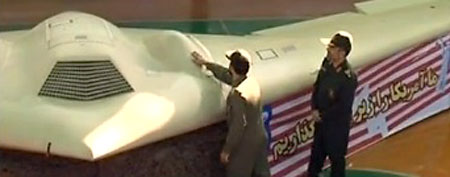Iran shows off captured U.S. drone on TV
-

Iran shows off captured U.S. drone on TV
Iran's Press TV on Thursday broadcast an extended video tour of the U.S. spy drone that went down in the country--and it indeed appeared to look mostly intact.
American officials have acknowledged that an unmanned U.S. reconnaissance plane was lost on a mission late last week, but have insisted that there is no evidence the drone was downed by hostile acts by Iran. Rather, they said, the drone likely went down because of a malfunction, and they implied the advanced stealth reconnaissance plane would likely have fallen from such a high altitude--the RQ-170 Sentinel can fly as high as 50,000 feet--that it wouldn't be in good shape.
But Iranian military officials have claimed since Sunday that they brought down an American spy drone that was little damaged. And now they have provided the first visual images of what looks to be a drone that at least outwardly appears to be in decent condition, in what is surely another humiliating poke in the eye for U.S. national security agencies.
The Pentagon declined to comment on the released images Thursday, a Defense Department spokesman told Yahoo News. But military analysts said it appeared to them to be the American drone in question.
"I have been doing this for thirty years, and it sure looks like" a stealthy U.S. drone to me," Loren Thompson, a military analyst with the Lexington Institute and consultant to the RQ-170's manufacturer, Lockheed Martin, told Yahoo News in a telephone interview Thursday. "I think we are going to face the high likelihood that Iran has an intact version of one of our most important intelligence gathering tools."
Still, Thompson went on, the intelligence "windfall" to Iran from obtaining the advanced U.S. stealthy drone may be mitigated.
"I don't think the Iranians get as much out of it as they might hope," he said. "It probably came into their hands as a result of a technical malfunction. What that means is they still don't have a real defense against the U.S. flying other vehicles that have similar capabilities, without much fear of interception."
Analysts also noted that the video of the drone released by Iran did not show the drone's underside. "Pretty intact," the Center for Strategic and International Studies' James Lewis said by email. "Interesting that they covered the underside."
The New York Times reported Thursday that--unsurprisingly--the RQ-170 was lost while making the latest foray over Iran during an extended CIA surveillance effort of Iran's nuclear and ballistic weapons program.
"The overflights by the bat-winged RQ-170 Sentinel, built by Lockheed Martin and first glimpsed on an airfield in Kandahar, Afghanistan, in 2009, are part of an increasingly aggressive intelligence collection program aimed at Iran, current and former officials say," the Times' Scott Shane and David Sanger wrote. "The urgency of the effort has been underscored by a recent public debate in Israel about whether time is running out for a military strike to slow Iran's progress toward a nuclear weapon."
Iran in turn has complained that the drone overflights represent an act of aggression and violation of its sovereignty, and summoned the Swiss envoy--who represents U.S. interests in Iran--on Thursday to lodge a protest.
However, while the images of the U.S. drone surely allowed Iran to score another public relations blow against Washington, Iran may find it tough to generate much in the way of international sympathy for being the target of U.S. surveillance.
Last week, Iranian hardliners ransacked the British embassy in Tehran, prompting the United Kingdom to recall its diplomatic staff from Tehran and order Iran's embassy in London closed. Last month, the UN atomic watchdog agency issued a report raising concerns about research Iran is suspected by some nations to have conducted before 2003 on military aspects of its nuclear program. Iran has insisted its nuclear program is for peaceful energy purposes. In October, the United States accused elements of Iran's Qods force of plotting to assassinate the Saudi envoy to the United States. The United Nations General Assembly voted last month in favor of a resolution condemning the Iranian plot.
Amid its growing international isolation, Iran, unsurprisingly, seemed intent to play up the drone incident for all it could.
"China, Russia want to inspect downed U.S. drone," proclaimed a headline from Iran's Mehr news agency Thursday.
The RQ-170 Sentinel, however, reportedly did not use the latest U.S. surveillance technology on board, in part because as a single-engine aircraft, it was thought more likely to occasionally go down.
"The basic principles of stealthy aircraft are fairly well known," Thompson said. "In terms of [the drone's] on-board electronics and information systems, it is fairly routine in combat to require authentication codes to make them hard to unlock."